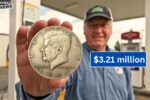A 1976 Bicentennial Quarter, worth up to $500,000, is turning heads among coin collectors. Minted to celebrate America’s 200th birthday, this quarter is more than just pocket change—it’s a piece of history. While most are worth only 25 cents, rare versions with unique errors or special features have sold for huge sums. Could one be hiding in your coin jar? Here’s the story of this iconic coin, why it’s so valuable, and how to spot a jackpot.
A Coin for America’s Big Celebration
In 1976, the U.S. Mint released special quarters to mark 200 years since the Declaration of Independence. The coins feature a Colonial drummer on the back, designed by Jack L. Ahr, with a torch and 13 stars for the original colonies. They show two dates, “1776-1976,” unlike regular quarters. Over 1.6 billion were made in Philadelphia and Denver, but a few rare ones, like those struck on silver planchets or with minting errors, are worth a fortune. One such coin fetched $500,000 at auction, making it a collector’s dream.
Why Some Are Worth So Much
Most Bicentennial Quarters are worth their face value, but certain versions stand out. Coins in perfect condition, graded MS-70 or PR-70 by services like PCGS, can sell for thousands. Rare errors, like double strikes or coins struck on silver planchets meant for proof sets, are the real prizes. For example, a 1976-S silver proof quarter sold for $13,500 in 2019, and another on a wrong planchet hit $500,000. The silver versions, made of 40% silver, are heavier and rarer than standard clad coins, boosting their value.
How to Spot a Valuable Quarter
Want to check your change? Here’s what to look for:
-
Check the dates: Look for “1776-1976” on the front.
-
Find the mint mark: A “D” means Denver, no mark means Philadelphia, and “S” means San Francisco (often silver).
-
Look for errors: Check for double strikes, misaligned designs, or a shiny proof finish.
-
Test the weight: Silver quarters are heavier (about 6.3 grams) than clad ones (5.67 grams).
-
Check condition: No scratches or wear means higher value.
If you think you’ve got a rare one, get it graded by PCGS or NGC to confirm its worth.
Are They Still Out There?
With billions minted, many 1976 Bicentennial Quarters are still in circulation or tucked away in collections. Some silver proofs or error coins slipped into everyday use, and stories of rare finds, like a $19,200 quarter sold a few years ago, keep hope alive. Check coin rolls from banks, old piggy banks, or family stashes. The chances are slim, but finding one could change your life.
Tips for Coin Hunters
Grab a magnifying glass and start searching your change. Look at quarters from 1975 or 1976, especially those with an “S” mint mark or unusual features. Coin clubs or websites like CoinValueChecker.com can teach you more about spotting rarities. Don’t clean your coins—cleaning can ruin their value. If you find a promising quarter, take it to a trusted dealer for appraisal. With a bit of luck, you might uncover a $500,000 treasure hiding in plain sight




